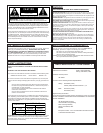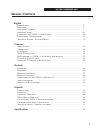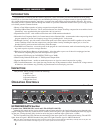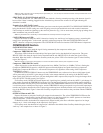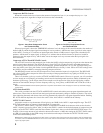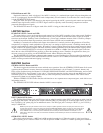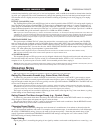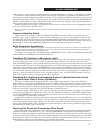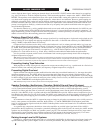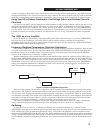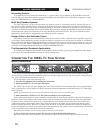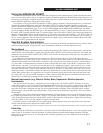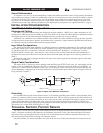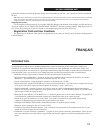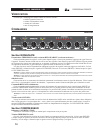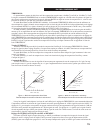
uration. Split the drum signal, sending one channel directly to the 166XL’s INPUT and the other channel to an equalizer
(e.g., dbx’s 20 Series or 30 Series Graphic Equalizer). Then connect the equalizer’s output to the 166XL’s SIDECHAIN
INSERT. The equalizer can be adjusted for boost with a peak of about 5kHz, causing the cymbal to be compressed on a
very loud crash, stopping tape saturation at high frequencies, where there is less headroom. However, gentle tapping of a
drumstick or brushing of the cymbal will not be affected. Assuming the tom-tom is a lower frequency instrument and can
be better tolerated by the tape, it has less need for compression. Equalization in the Sidechain circuit means that the com-
pressor is not triggered as readily by a loud tom-tom beat as by an equally loud cymbal crash. Refer to the next page for
more Sidechain applications.
For drum kit submixes (e.g., mixing multiple drum tracks to two tracks while using both channels of a 166XL for com-
pression), consider backing off the RATIO on each channel (down to 2:1) to avoid an excess of cymbal “splattering.” In
larger multitracking systems, compress the kick and snare separately. A further possibility is to heavily compress a stereo
submix of toms and leave the remaining percussives unaffected.
Raising a Signal Out of a Mix
Since reducing dynamic range increases the average signal level by a small amount, a single track can be raised out of a
mix by boosting its level slightly and applying compression. Start with a 2:1 RATIO and a relatively low THRESHOLD
setting (-20dBu). Adjust both controls as necessary.
Compressors have also been used to bring vocals to the forefront of a mix in volume-restricted studios (e.g. home stu-
dios). Start by adding a foam windscreen to the mic (if it doesn’t have one). Set the RATIO to 10:1 and the THRESHOLD
to -10dBu. With your mouth approximately 2 inches from the mic, sing the vocal part, but with less volume than normal.
Use phrasing to give the part some intensity. An equalizer (e.g., a dbx 20 Series Equalizer or dbx 30 Series Graphic
Equalizer) or a vocal effects device (e.g., reverb, delay, distortion) can be added to further define the performance.
It is also possible to separate certain vocals or instruments from a mono program already mixed: refer to frequency-
weighted compression on page 9.
Note: When compressing a stereo program with a 166XL, the factors affecting a compression curve and the actual RATIO and THRESHOLD settings, are
like those previously covered with reference to single channels of program material. However, it will generally be found that large amounts of compression
are more audible in a mixed stereo program than they might be on the separate tracks that were mixed to create the program.
Preventing Analog Tape Saturation
With programs of widely varying levels, compression can prevent recording levels (e.g., cymbal tracks in a final mix or
drum kit submix) from saturating tape tracks (see frequency-weighted compression, on page 9).
Preventing Digital Overload
Digital recorders and samplers produce audible distortion when they exceed their headroom (i.e., the range above their
maximum operating level). The 166XL effectively ensures that audio input does not overload a digital recorder’s A/D
(analog-to-digital) converters. The 166XL can perform this function quietly enough for all digital media. To use the 166XL
so that no changes in gain occur unless an emergency arises (wildly excessive levels), set Hard Knee mode On, the RATIO
to !:1, and the THRESHOLD to the highest permissible level.
Note: PeakStop limiting can also be used to prevent raucous-sounding digital overload.
Speaker Protection (Auditoriums, Churches, Mobile DJs and Sound Systems)
Compressors are frequently used to prevent excessive program levels from distorting power amps and/or damaging dri-
vers in a sound-reinforcement system (whether you’re doing auditorium, church, or club sound engineering, or are a
mobile DJ, or like to push the limits of your home’s audio entertainment center). Set the 166XL for limiting (Hard Knee
mode On, with a RATIO of 10:1 or greater) and adjust the THRESHOLD to provide 15dB or more of compression (just a
few dB below the input clip). For low-level signals, the 166XL won’t change gain, but if large signals come along, the gain
will be reduced to prevent clipping and save sensitive system components from excessive heat buildup or other type of
damage.
In circumstances where the 166XL is expected to cause no change in gain unless an emergency arises (wildly excessive
levels), some operators set Hard Knee mode On, the RATIO to !:1, and the THRESHOLD to the highest permissible
level. As with preventing digital overload, the 166XL’s PeakStop limiter can be used instead of or in combination with the
166XL’s compression.
As a general rule, compressors should be as close to the amplifiers as possible in the signal chain. If the 166XL is
placed before the EQ (equalizer), for example, a potentially damaging boost in the EQ won’t be seen by the 166XL and the
speakers may be damaged. (see Multi-way speaker systems, page 10). For maximum sound pressure levels, large sound
reinforcement systems frequently use a separate compressor on each output of the electronic crossover(s). For a stereo
sound-reinforcement system, one 166XL can be used for each stereo band (low, low-mid, mid, etc.).
Raising Average Level in PA Systems
Limiting (i.e., compression at high ratios like !:1) also benefits intelligibility by allowing low-level input signals to be
reproduced through the system at higher volume. In a musical performance, this provides additional intimacy so that a
8
®
PROFESSIONAL PRODUCTS
dbx 166XL COMPRESSOR / GATE



